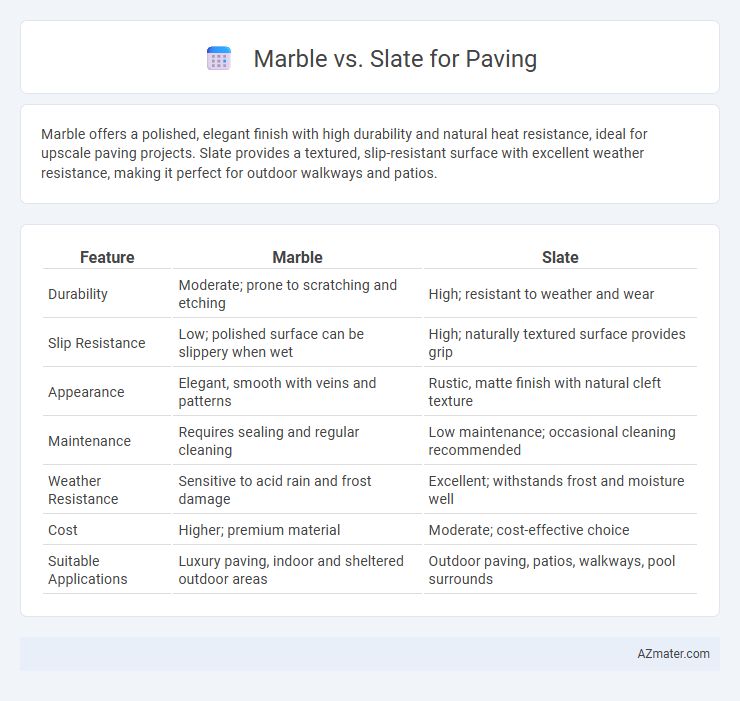Marble offers a polished, elegant finish with high durability and natural heat resistance, ideal for upscale paving projects. Slate provides a textured, slip-resistant surface with excellent weather resistance, making it perfect for outdoor walkways and patios.
Table of Comparison
| Feature | Marble | Slate |
|---|---|---|
| Durability | Moderate; prone to scratching and etching | High; resistant to weather and wear |
| Slip Resistance | Low; polished surface can be slippery when wet | High; naturally textured surface provides grip |
| Appearance | Elegant, smooth with veins and patterns | Rustic, matte finish with natural cleft texture |
| Maintenance | Requires sealing and regular cleaning | Low maintenance; occasional cleaning recommended |
| Weather Resistance | Sensitive to acid rain and frost damage | Excellent; withstands frost and moisture well |
| Cost | Higher; premium material | Moderate; cost-effective choice |
| Suitable Applications | Luxury paving, indoor and sheltered outdoor areas | Outdoor paving, patios, walkways, pool surrounds |
Introduction to Marble and Slate Paving
Marble paving offers a luxurious, polished surface known for its elegant veining and high durability, making it ideal for upscale outdoor spaces and patios. Slate paving features a natural, textured finish with exceptional slip resistance and a range of earthy colors, perfect for rustic or contemporary garden paths. Both materials provide unique aesthetic and functional advantages, with marble emphasizing refined beauty and slate prioritizing rugged practicality.
Appearance and Aesthetic Differences
Marble offers a smooth, glossy surface with a range of light, elegant tones that create a luxurious and timeless aesthetic for paving. Slate provides a textured, matte finish with natural clefts and rich earthy hues like gray, green, and rust, delivering a rustic, organic appeal. The choice between marble and slate significantly impacts the visual ambiance, with marble favoring refined sophistication and slate emphasizing natural, rugged beauty.
Durability and Strength Comparison
Marble offers a luxurious appearance but is softer and more prone to scratching and staining compared to slate, which is known for its exceptional durability and resistance to weathering, making it ideal for outdoor paving. Slate's dense, fine-grained composition provides superior strength and slip resistance, enhancing safety and longevity in high-traffic areas. The natural cleft texture of slate also preserves its structural integrity better under heavy foot traffic and environmental stress than the more porous and brittle marble.
Slip Resistance and Safety
Slate offers superior slip resistance compared to marble, making it a safer choice for paving in wet or high-traffic areas due to its naturally textured surface. Marble's smooth and polished finish can become slippery when wet, increasing the risk of falls, especially in outdoor or poolside settings. Choosing slate for paving enhances safety by providing better traction, reducing slip hazards in residential and commercial environments.
Maintenance Requirements
Marble paving requires regular sealing and prompt cleaning to prevent staining and etching from acidic substances, making maintenance more intensive compared to slate. Slate naturally resists stains and scratches, requiring only periodic sealing and routine sweeping to maintain its appearance. Proper maintenance of both materials extends their lifespan, but slate's lower upkeep demands make it a more practical choice for high-traffic outdoor areas.
Weather and Climate Suitability
Marble offers a polished, elegant look but can become slippery when wet, making it less suitable for regions with frequent rain or frost. Slate's natural cleft surface provides excellent slip resistance and durability, ideal for areas with diverse weather conditions including freeze-thaw cycles. Both materials require sealing to protect against moisture penetration, but slate generally withstands harsh climates better due to its dense, non-porous composition.
Installation and Workability
Marble offers easier installation due to its uniform thickness and smooth surface, allowing for precise cuts and faster fitting in paving projects. Slate requires more skill during installation because of its natural cleft surface and variable thickness, which can complicate alignment and leveling. Workability favors marble for straightforward handling, while slate demands experienced craftsmanship to ensure durability and aesthetic appeal in paving applications.
Cost Considerations
Marble paving typically incurs higher costs due to its luxurious appearance and labor-intensive installation compared to slate, which is generally more affordable and durable for outdoor surfaces. Slate offers lower maintenance expenses and greater resistance to weathering, reducing long-term investment despite its initial modest price. Cost considerations should also include regional availability and sourcing, as imported marble can significantly increase overall expenses.
Eco-Friendliness and Sustainability
Slate is more eco-friendly than marble for paving due to its natural durability, low energy consumption during extraction, and minimal processing requirements. Marble, although elegant, requires intensive quarrying and high-energy polishing, increasing its environmental footprint. Choosing slate supports sustainable paving practices by reducing resource depletion and promoting long-lasting, maintenance-friendly surfaces.
Best Applications for Marble and Slate Paving
Marble paving excels in luxurious indoor settings, such as grand foyers and upscale patios, where its smooth texture and elegant veining create a sophisticated atmosphere. Slate paving offers superior durability and slip resistance, making it ideal for outdoor pathways, pool surrounds, and garden patios exposed to moisture and heavy foot traffic. Both materials provide distinct aesthetic and functional benefits tailored to specific paving applications.

Infographic: Marble vs Slate for Paving
 azmater.com
azmater.com